Report: Analysis of Business Organisation - Hilton Budapest Hotel
VerifiedAdded on 2020/06/06
|14
|3358
|24
Report
AI Summary
This report provides a comprehensive business analysis of the Hilton Budapest Hotel, a 5-star establishment in Hungary. It begins with an introduction to the hotel's background, its association with the Hilton brand, and its operational objectives. The report then delves into a discussion of the business organization, focusing on its market presence and operational strategies. A PESTLE analysis is conducted to evaluate the political, economic, social, technological, legal, and environmental factors influencing the hotel. The analysis continues with an examination of the business scenario and the application of Porter's Five Forces model to assess the competitive landscape, including the threat of new entrants, bargaining power of buyers and suppliers, and competitive rivalry. The report concludes with a summary of the key findings and implications for the hotel's strategic planning and future growth within the Hungarian and global hospitality markets.
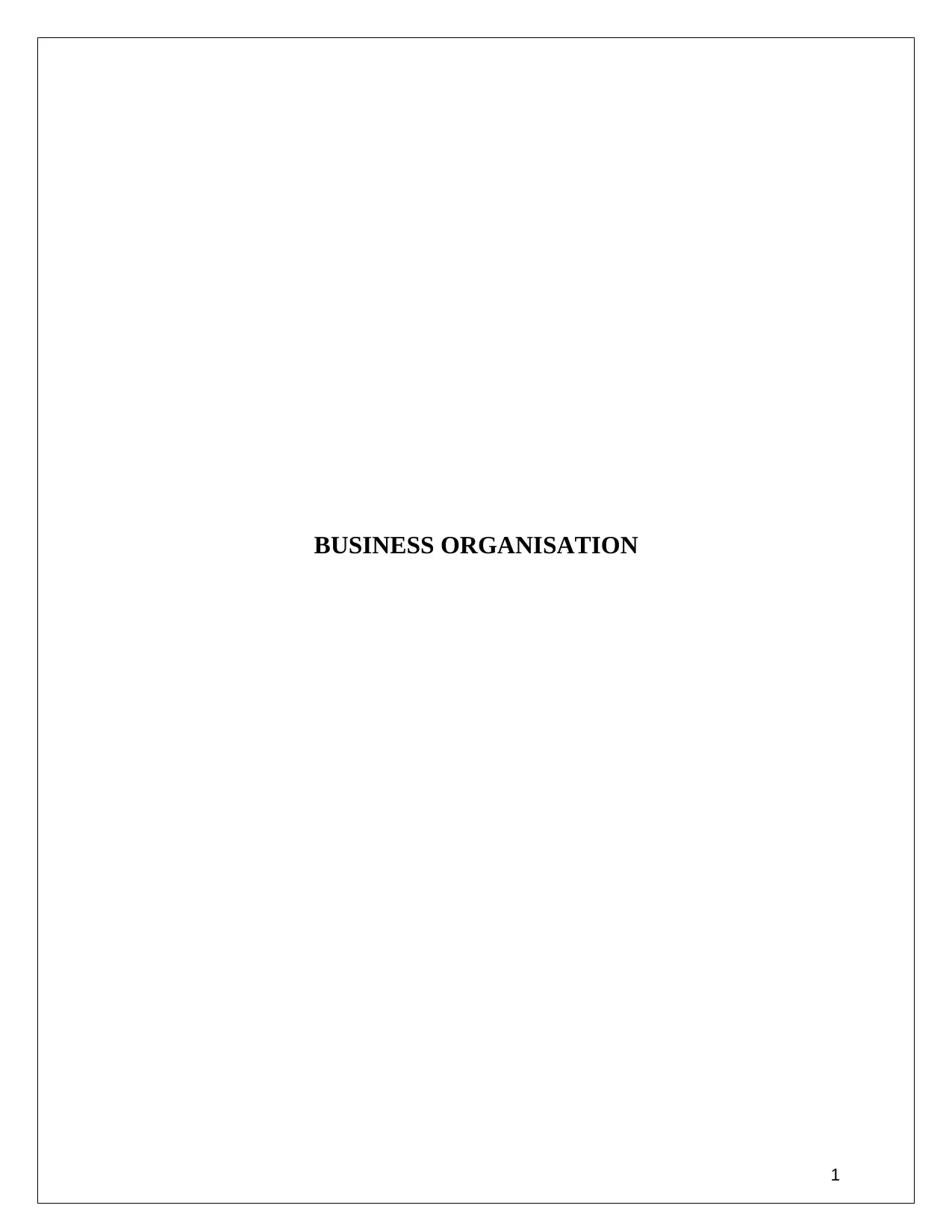
BUSINESS ORGANISATION
1
1
Paraphrase This Document
Need a fresh take? Get an instant paraphrase of this document with our AI Paraphraser
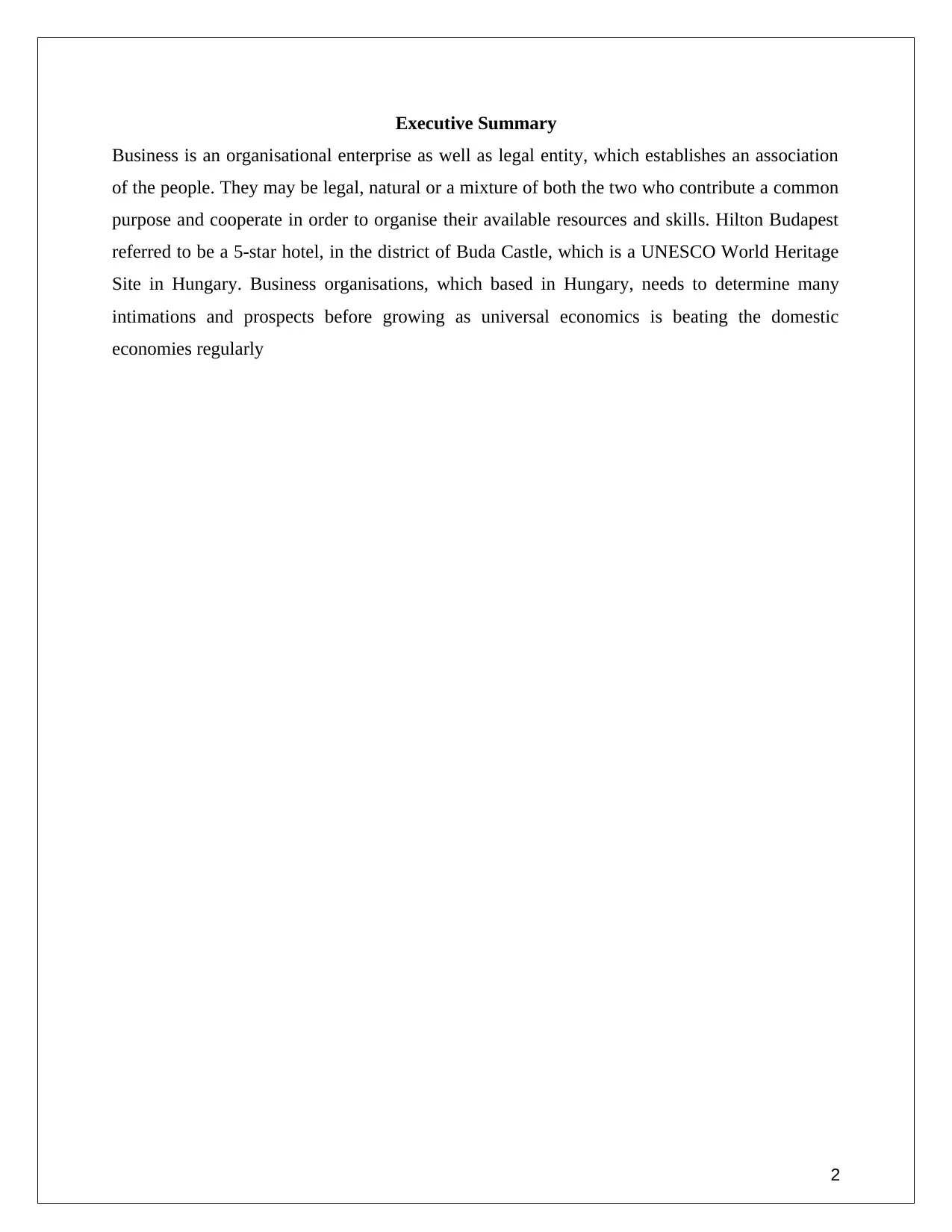
Executive Summary
Business is an organisational enterprise as well as legal entity, which establishes an association
of the people. They may be legal, natural or a mixture of both the two who contribute a common
purpose and cooperate in order to organise their available resources and skills. Hilton Budapest
referred to be a 5-star hotel, in the district of Buda Castle, which is a UNESCO World Heritage
Site in Hungary. Business organisations, which based in Hungary, needs to determine many
intimations and prospects before growing as universal economics is beating the domestic
economies regularly
2
Business is an organisational enterprise as well as legal entity, which establishes an association
of the people. They may be legal, natural or a mixture of both the two who contribute a common
purpose and cooperate in order to organise their available resources and skills. Hilton Budapest
referred to be a 5-star hotel, in the district of Buda Castle, which is a UNESCO World Heritage
Site in Hungary. Business organisations, which based in Hungary, needs to determine many
intimations and prospects before growing as universal economics is beating the domestic
economies regularly
2
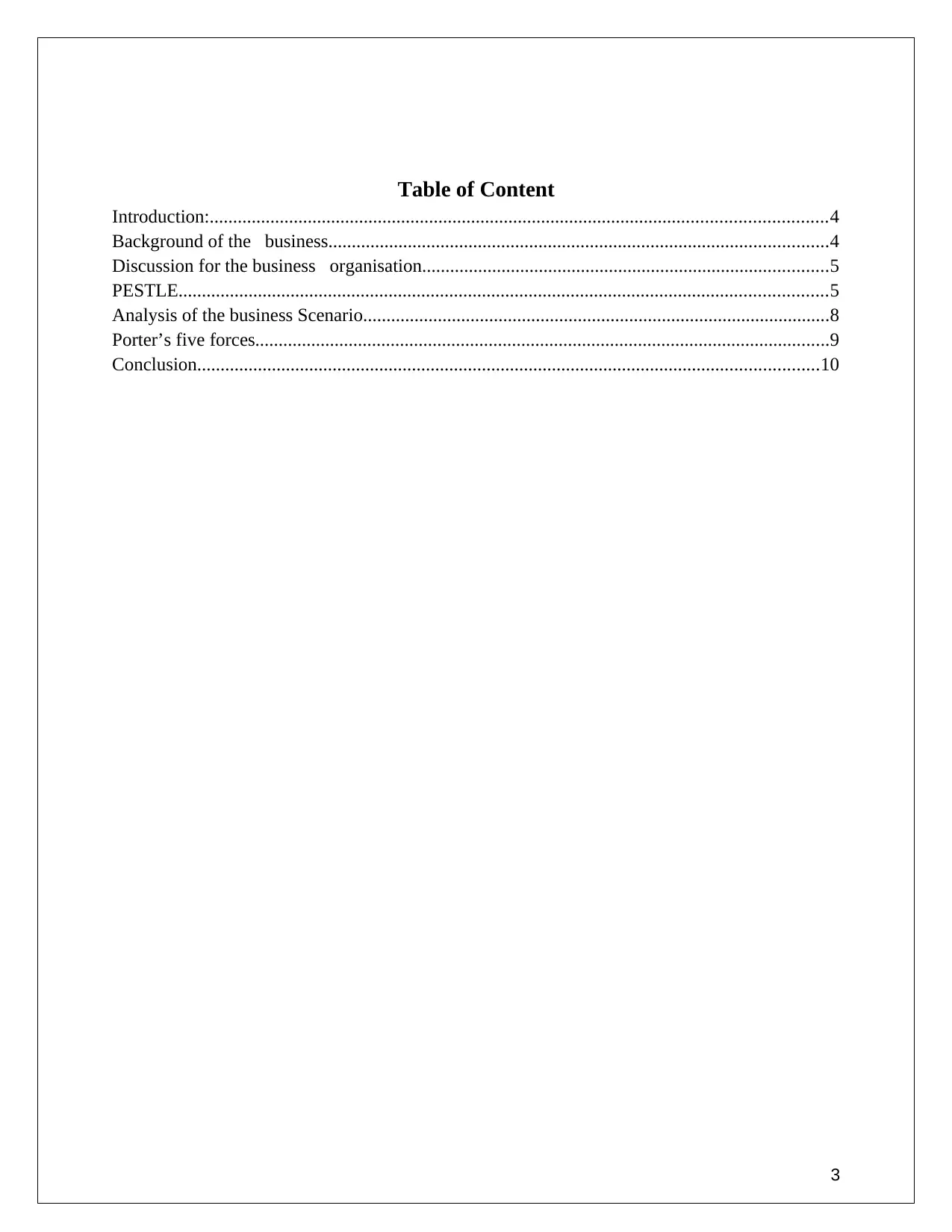
Table of Content
Introduction:....................................................................................................................................4
Background of the business...........................................................................................................4
Discussion for the business organisation.......................................................................................5
PESTLE...........................................................................................................................................5
Analysis of the business Scenario....................................................................................................8
Porter’s five forces...........................................................................................................................9
Conclusion.....................................................................................................................................10
3
Introduction:....................................................................................................................................4
Background of the business...........................................................................................................4
Discussion for the business organisation.......................................................................................5
PESTLE...........................................................................................................................................5
Analysis of the business Scenario....................................................................................................8
Porter’s five forces...........................................................................................................................9
Conclusion.....................................................................................................................................10
3
⊘ This is a preview!⊘
Do you want full access?
Subscribe today to unlock all pages.

Trusted by 1+ million students worldwide
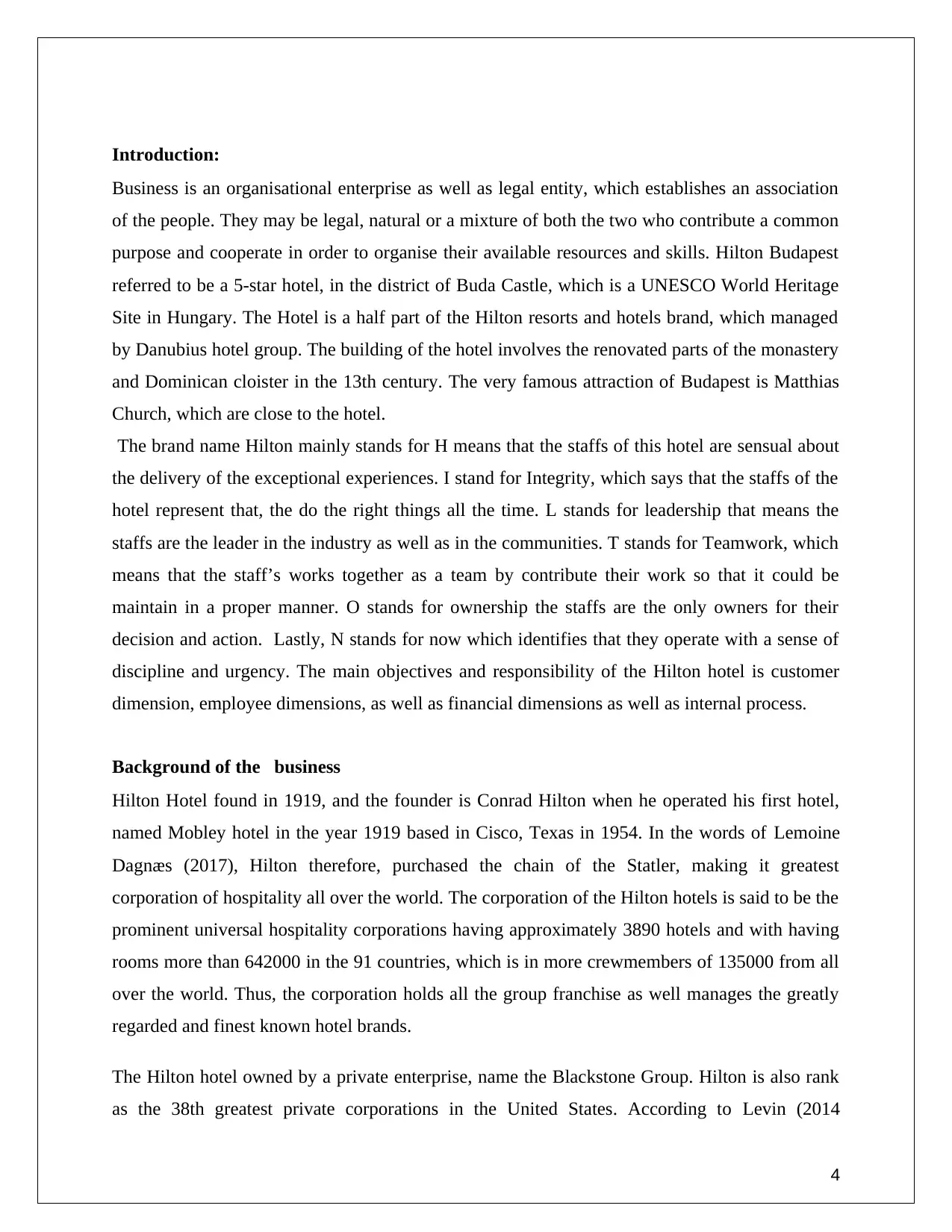
Introduction:
Business is an organisational enterprise as well as legal entity, which establishes an association
of the people. They may be legal, natural or a mixture of both the two who contribute a common
purpose and cooperate in order to organise their available resources and skills. Hilton Budapest
referred to be a 5-star hotel, in the district of Buda Castle, which is a UNESCO World Heritage
Site in Hungary. The Hotel is a half part of the Hilton resorts and hotels brand, which managed
by Danubius hotel group. The building of the hotel involves the renovated parts of the monastery
and Dominican cloister in the 13th century. The very famous attraction of Budapest is Matthias
Church, which are close to the hotel.
The brand name Hilton mainly stands for H means that the staffs of this hotel are sensual about
the delivery of the exceptional experiences. I stand for Integrity, which says that the staffs of the
hotel represent that, the do the right things all the time. L stands for leadership that means the
staffs are the leader in the industry as well as in the communities. T stands for Teamwork, which
means that the staff’s works together as a team by contribute their work so that it could be
maintain in a proper manner. O stands for ownership the staffs are the only owners for their
decision and action. Lastly, N stands for now which identifies that they operate with a sense of
discipline and urgency. The main objectives and responsibility of the Hilton hotel is customer
dimension, employee dimensions, as well as financial dimensions as well as internal process.
Background of the business
Hilton Hotel found in 1919, and the founder is Conrad Hilton when he operated his first hotel,
named Mobley hotel in the year 1919 based in Cisco, Texas in 1954. In the words of Lemoine
Dagnæs (2017), Hilton therefore, purchased the chain of the Statler, making it greatest
corporation of hospitality all over the world. The corporation of the Hilton hotels is said to be the
prominent universal hospitality corporations having approximately 3890 hotels and with having
rooms more than 642000 in the 91 countries, which is in more crewmembers of 135000 from all
over the world. Thus, the corporation holds all the group franchise as well manages the greatly
regarded and finest known hotel brands.
The Hilton hotel owned by a private enterprise, name the Blackstone Group. Hilton is also rank
as the 38th greatest private corporations in the United States. According to Levin (2014
4
Business is an organisational enterprise as well as legal entity, which establishes an association
of the people. They may be legal, natural or a mixture of both the two who contribute a common
purpose and cooperate in order to organise their available resources and skills. Hilton Budapest
referred to be a 5-star hotel, in the district of Buda Castle, which is a UNESCO World Heritage
Site in Hungary. The Hotel is a half part of the Hilton resorts and hotels brand, which managed
by Danubius hotel group. The building of the hotel involves the renovated parts of the monastery
and Dominican cloister in the 13th century. The very famous attraction of Budapest is Matthias
Church, which are close to the hotel.
The brand name Hilton mainly stands for H means that the staffs of this hotel are sensual about
the delivery of the exceptional experiences. I stand for Integrity, which says that the staffs of the
hotel represent that, the do the right things all the time. L stands for leadership that means the
staffs are the leader in the industry as well as in the communities. T stands for Teamwork, which
means that the staff’s works together as a team by contribute their work so that it could be
maintain in a proper manner. O stands for ownership the staffs are the only owners for their
decision and action. Lastly, N stands for now which identifies that they operate with a sense of
discipline and urgency. The main objectives and responsibility of the Hilton hotel is customer
dimension, employee dimensions, as well as financial dimensions as well as internal process.
Background of the business
Hilton Hotel found in 1919, and the founder is Conrad Hilton when he operated his first hotel,
named Mobley hotel in the year 1919 based in Cisco, Texas in 1954. In the words of Lemoine
Dagnæs (2017), Hilton therefore, purchased the chain of the Statler, making it greatest
corporation of hospitality all over the world. The corporation of the Hilton hotels is said to be the
prominent universal hospitality corporations having approximately 3890 hotels and with having
rooms more than 642000 in the 91 countries, which is in more crewmembers of 135000 from all
over the world. Thus, the corporation holds all the group franchise as well manages the greatly
regarded and finest known hotel brands.
The Hilton hotel owned by a private enterprise, name the Blackstone Group. Hilton is also rank
as the 38th greatest private corporations in the United States. According to Levin (2014
4
Paraphrase This Document
Need a fresh take? Get an instant paraphrase of this document with our AI Paraphraser
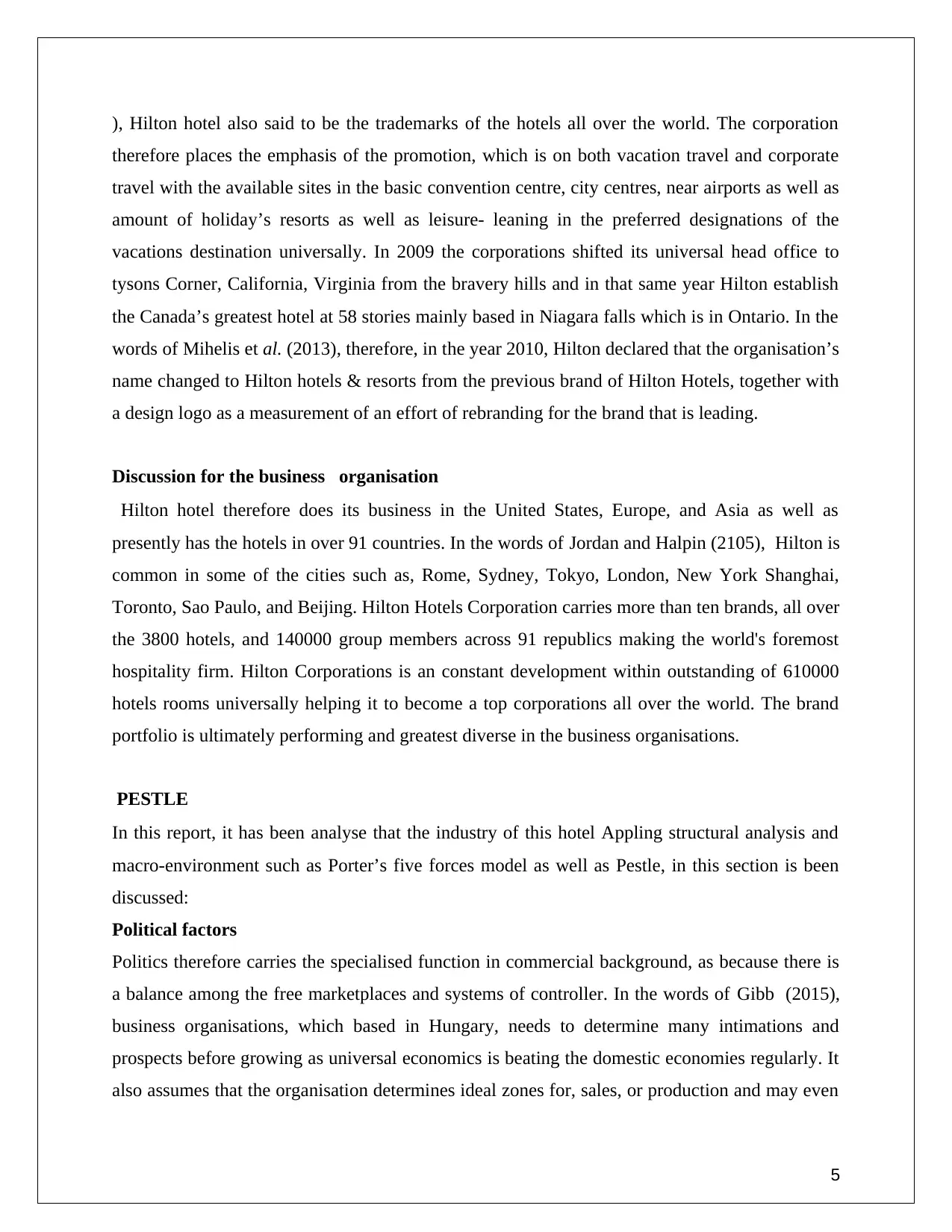
), Hilton hotel also said to be the trademarks of the hotels all over the world. The corporation
therefore places the emphasis of the promotion, which is on both vacation travel and corporate
travel with the available sites in the basic convention centre, city centres, near airports as well as
amount of holiday’s resorts as well as leisure- leaning in the preferred designations of the
vacations destination universally. In 2009 the corporations shifted its universal head office to
tysons Corner, California, Virginia from the bravery hills and in that same year Hilton establish
the Canada’s greatest hotel at 58 stories mainly based in Niagara falls which is in Ontario. In the
words of Mihelis et al. (2013), therefore, in the year 2010, Hilton declared that the organisation’s
name changed to Hilton hotels & resorts from the previous brand of Hilton Hotels, together with
a design logo as a measurement of an effort of rebranding for the brand that is leading.
Discussion for the business organisation
Hilton hotel therefore does its business in the United States, Europe, and Asia as well as
presently has the hotels in over 91 countries. In the words of Jordan and Halpin (2105), Hilton is
common in some of the cities such as, Rome, Sydney, Tokyo, London, New York Shanghai,
Toronto, Sao Paulo, and Beijing. Hilton Hotels Corporation carries more than ten brands, all over
the 3800 hotels, and 140000 group members across 91 republics making the world's foremost
hospitality firm. Hilton Corporations is an constant development within outstanding of 610000
hotels rooms universally helping it to become a top corporations all over the world. The brand
portfolio is ultimately performing and greatest diverse in the business organisations.
PESTLE
In this report, it has been analyse that the industry of this hotel Appling structural analysis and
macro-environment such as Porter’s five forces model as well as Pestle, in this section is been
discussed:
Political factors
Politics therefore carries the specialised function in commercial background, as because there is
a balance among the free marketplaces and systems of controller. In the words of Gibb (2015),
business organisations, which based in Hungary, needs to determine many intimations and
prospects before growing as universal economics is beating the domestic economies regularly. It
also assumes that the organisation determines ideal zones for, sales, or production and may even
5
therefore places the emphasis of the promotion, which is on both vacation travel and corporate
travel with the available sites in the basic convention centre, city centres, near airports as well as
amount of holiday’s resorts as well as leisure- leaning in the preferred designations of the
vacations destination universally. In 2009 the corporations shifted its universal head office to
tysons Corner, California, Virginia from the bravery hills and in that same year Hilton establish
the Canada’s greatest hotel at 58 stories mainly based in Niagara falls which is in Ontario. In the
words of Mihelis et al. (2013), therefore, in the year 2010, Hilton declared that the organisation’s
name changed to Hilton hotels & resorts from the previous brand of Hilton Hotels, together with
a design logo as a measurement of an effort of rebranding for the brand that is leading.
Discussion for the business organisation
Hilton hotel therefore does its business in the United States, Europe, and Asia as well as
presently has the hotels in over 91 countries. In the words of Jordan and Halpin (2105), Hilton is
common in some of the cities such as, Rome, Sydney, Tokyo, London, New York Shanghai,
Toronto, Sao Paulo, and Beijing. Hilton Hotels Corporation carries more than ten brands, all over
the 3800 hotels, and 140000 group members across 91 republics making the world's foremost
hospitality firm. Hilton Corporations is an constant development within outstanding of 610000
hotels rooms universally helping it to become a top corporations all over the world. The brand
portfolio is ultimately performing and greatest diverse in the business organisations.
PESTLE
In this report, it has been analyse that the industry of this hotel Appling structural analysis and
macro-environment such as Porter’s five forces model as well as Pestle, in this section is been
discussed:
Political factors
Politics therefore carries the specialised function in commercial background, as because there is
a balance among the free marketplaces and systems of controller. In the words of Gibb (2015),
business organisations, which based in Hungary, needs to determine many intimations and
prospects before growing as universal economics is beating the domestic economies regularly. It
also assumes that the organisation determines ideal zones for, sales, or production and may even
5
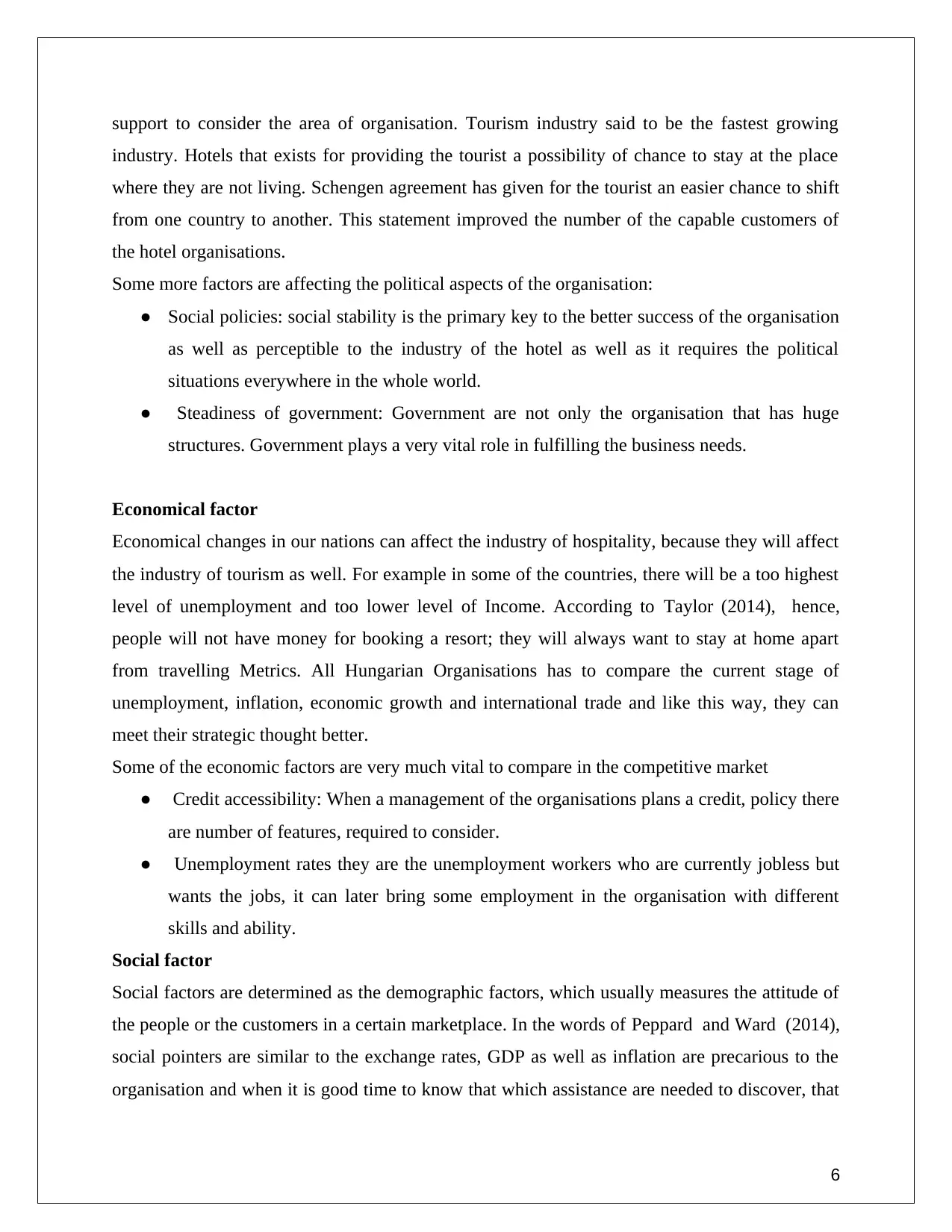
support to consider the area of organisation. Tourism industry said to be the fastest growing
industry. Hotels that exists for providing the tourist a possibility of chance to stay at the place
where they are not living. Schengen agreement has given for the tourist an easier chance to shift
from one country to another. This statement improved the number of the capable customers of
the hotel organisations.
Some more factors are affecting the political aspects of the organisation:
● Social policies: social stability is the primary key to the better success of the organisation
as well as perceptible to the industry of the hotel as well as it requires the political
situations everywhere in the whole world.
● Steadiness of government: Government are not only the organisation that has huge
structures. Government plays a very vital role in fulfilling the business needs.
Economical factor
Economical changes in our nations can affect the industry of hospitality, because they will affect
the industry of tourism as well. For example in some of the countries, there will be a too highest
level of unemployment and too lower level of Income. According to Taylor (2014), hence,
people will not have money for booking a resort; they will always want to stay at home apart
from travelling Metrics. All Hungarian Organisations has to compare the current stage of
unemployment, inflation, economic growth and international trade and like this way, they can
meet their strategic thought better.
Some of the economic factors are very much vital to compare in the competitive market
● Credit accessibility: When a management of the organisations plans a credit, policy there
are number of features, required to consider.
● Unemployment rates they are the unemployment workers who are currently jobless but
wants the jobs, it can later bring some employment in the organisation with different
skills and ability.
Social factor
Social factors are determined as the demographic factors, which usually measures the attitude of
the people or the customers in a certain marketplace. In the words of Peppard and Ward (2014),
social pointers are similar to the exchange rates, GDP as well as inflation are precarious to the
organisation and when it is good time to know that which assistance are needed to discover, that
6
industry. Hotels that exists for providing the tourist a possibility of chance to stay at the place
where they are not living. Schengen agreement has given for the tourist an easier chance to shift
from one country to another. This statement improved the number of the capable customers of
the hotel organisations.
Some more factors are affecting the political aspects of the organisation:
● Social policies: social stability is the primary key to the better success of the organisation
as well as perceptible to the industry of the hotel as well as it requires the political
situations everywhere in the whole world.
● Steadiness of government: Government are not only the organisation that has huge
structures. Government plays a very vital role in fulfilling the business needs.
Economical factor
Economical changes in our nations can affect the industry of hospitality, because they will affect
the industry of tourism as well. For example in some of the countries, there will be a too highest
level of unemployment and too lower level of Income. According to Taylor (2014), hence,
people will not have money for booking a resort; they will always want to stay at home apart
from travelling Metrics. All Hungarian Organisations has to compare the current stage of
unemployment, inflation, economic growth and international trade and like this way, they can
meet their strategic thought better.
Some of the economic factors are very much vital to compare in the competitive market
● Credit accessibility: When a management of the organisations plans a credit, policy there
are number of features, required to consider.
● Unemployment rates they are the unemployment workers who are currently jobless but
wants the jobs, it can later bring some employment in the organisation with different
skills and ability.
Social factor
Social factors are determined as the demographic factors, which usually measures the attitude of
the people or the customers in a certain marketplace. In the words of Peppard and Ward (2014),
social pointers are similar to the exchange rates, GDP as well as inflation are precarious to the
organisation and when it is good time to know that which assistance are needed to discover, that
6
⊘ This is a preview!⊘
Do you want full access?
Subscribe today to unlock all pages.

Trusted by 1+ million students worldwide
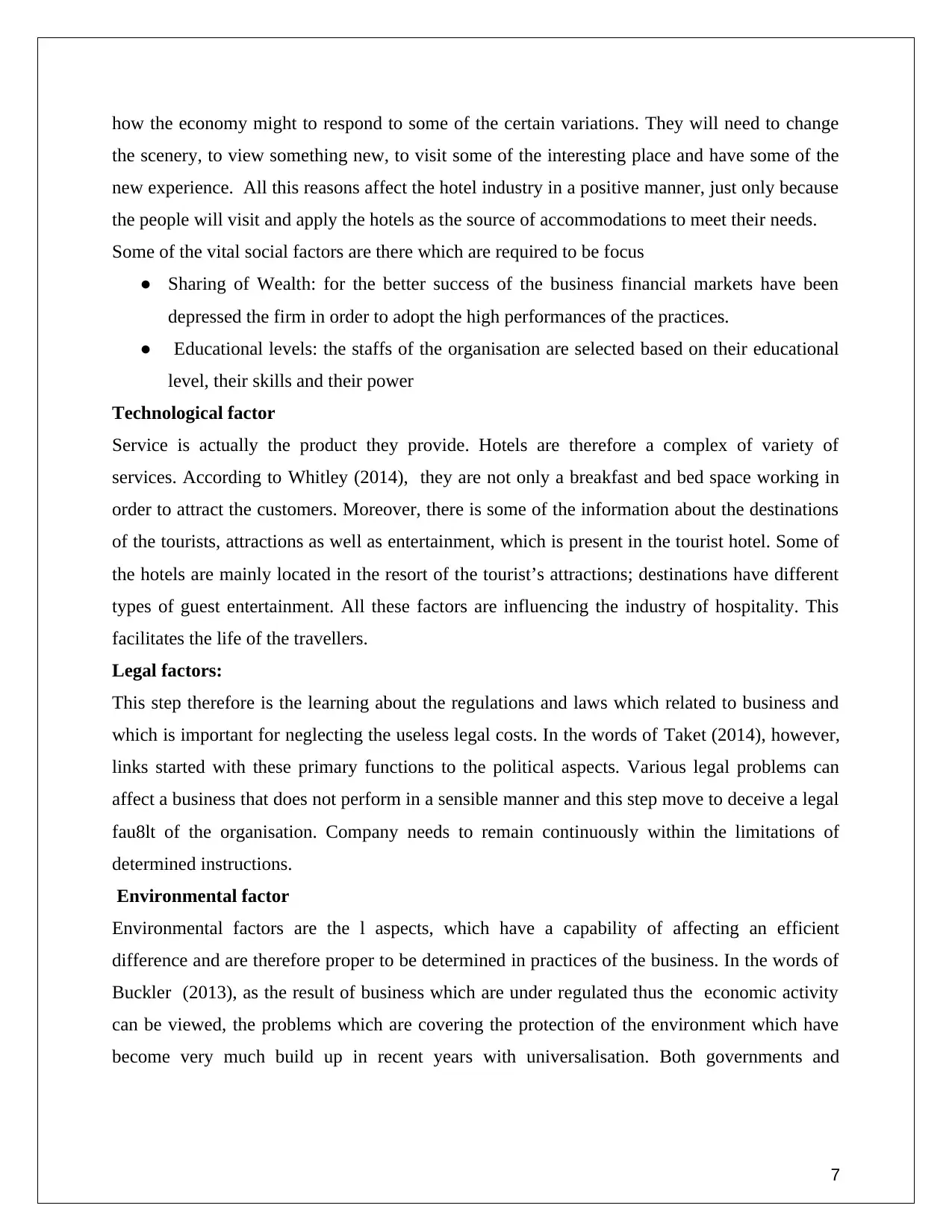
how the economy might to respond to some of the certain variations. They will need to change
the scenery, to view something new, to visit some of the interesting place and have some of the
new experience. All this reasons affect the hotel industry in a positive manner, just only because
the people will visit and apply the hotels as the source of accommodations to meet their needs.
Some of the vital social factors are there which are required to be focus
● Sharing of Wealth: for the better success of the business financial markets have been
depressed the firm in order to adopt the high performances of the practices.
● Educational levels: the staffs of the organisation are selected based on their educational
level, their skills and their power
Technological factor
Service is actually the product they provide. Hotels are therefore a complex of variety of
services. According to Whitley (2014), they are not only a breakfast and bed space working in
order to attract the customers. Moreover, there is some of the information about the destinations
of the tourists, attractions as well as entertainment, which is present in the tourist hotel. Some of
the hotels are mainly located in the resort of the tourist’s attractions; destinations have different
types of guest entertainment. All these factors are influencing the industry of hospitality. This
facilitates the life of the travellers.
Legal factors:
This step therefore is the learning about the regulations and laws which related to business and
which is important for neglecting the useless legal costs. In the words of Taket (2014), however,
links started with these primary functions to the political aspects. Various legal problems can
affect a business that does not perform in a sensible manner and this step move to deceive a legal
fau8lt of the organisation. Company needs to remain continuously within the limitations of
determined instructions.
Environmental factor
Environmental factors are the l aspects, which have a capability of affecting an efficient
difference and are therefore proper to be determined in practices of the business. In the words of
Buckler (2013), as the result of business which are under regulated thus the economic activity
can be viewed, the problems which are covering the protection of the environment which have
become very much build up in recent years with universalisation. Both governments and
7
the scenery, to view something new, to visit some of the interesting place and have some of the
new experience. All this reasons affect the hotel industry in a positive manner, just only because
the people will visit and apply the hotels as the source of accommodations to meet their needs.
Some of the vital social factors are there which are required to be focus
● Sharing of Wealth: for the better success of the business financial markets have been
depressed the firm in order to adopt the high performances of the practices.
● Educational levels: the staffs of the organisation are selected based on their educational
level, their skills and their power
Technological factor
Service is actually the product they provide. Hotels are therefore a complex of variety of
services. According to Whitley (2014), they are not only a breakfast and bed space working in
order to attract the customers. Moreover, there is some of the information about the destinations
of the tourists, attractions as well as entertainment, which is present in the tourist hotel. Some of
the hotels are mainly located in the resort of the tourist’s attractions; destinations have different
types of guest entertainment. All these factors are influencing the industry of hospitality. This
facilitates the life of the travellers.
Legal factors:
This step therefore is the learning about the regulations and laws which related to business and
which is important for neglecting the useless legal costs. In the words of Taket (2014), however,
links started with these primary functions to the political aspects. Various legal problems can
affect a business that does not perform in a sensible manner and this step move to deceive a legal
fau8lt of the organisation. Company needs to remain continuously within the limitations of
determined instructions.
Environmental factor
Environmental factors are the l aspects, which have a capability of affecting an efficient
difference and are therefore proper to be determined in practices of the business. In the words of
Buckler (2013), as the result of business which are under regulated thus the economic activity
can be viewed, the problems which are covering the protection of the environment which have
become very much build up in recent years with universalisation. Both governments and
7
Paraphrase This Document
Need a fresh take? Get an instant paraphrase of this document with our AI Paraphraser
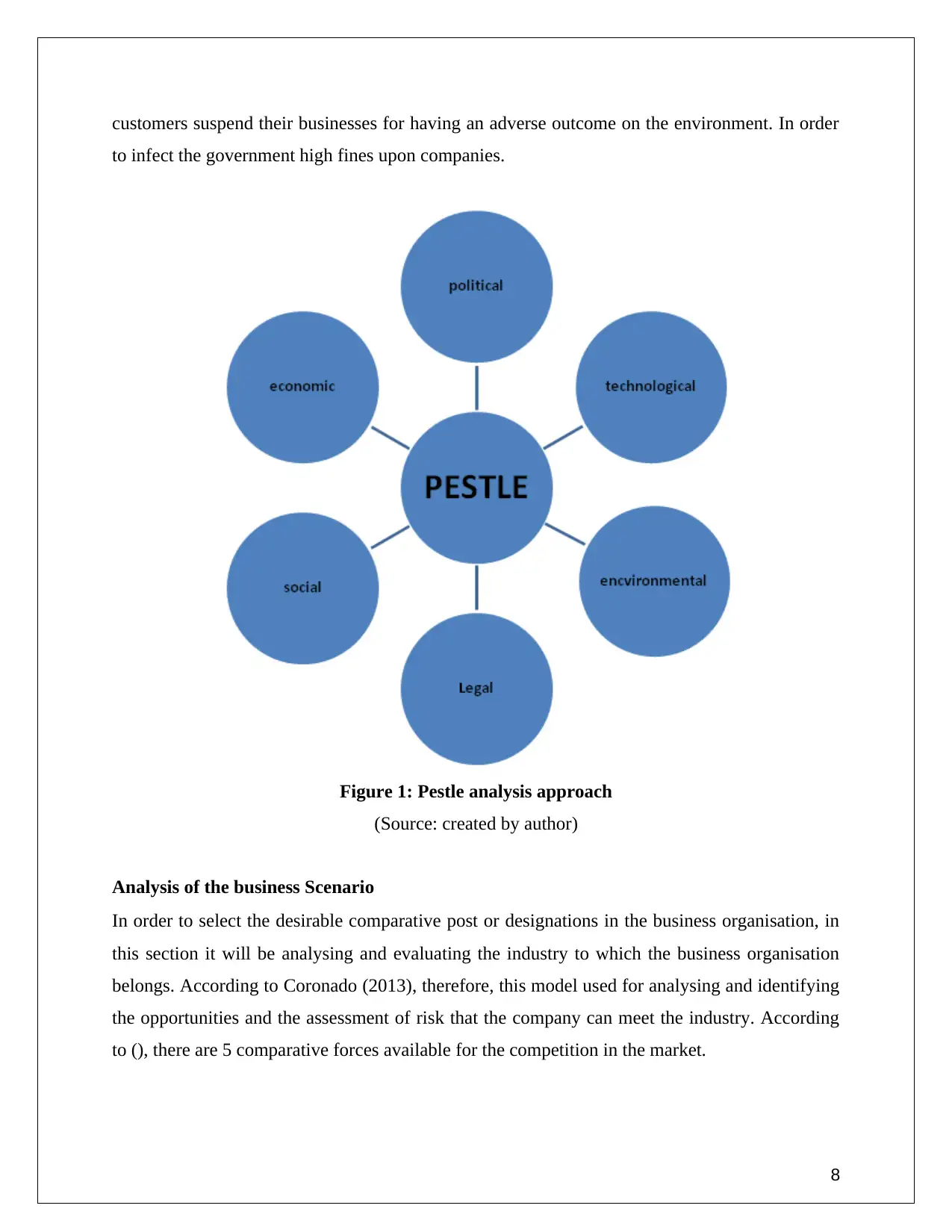
customers suspend their businesses for having an adverse outcome on the environment. In order
to infect the government high fines upon companies.
Figure 1: Pestle analysis approach
(Source: created by author)
Analysis of the business Scenario
In order to select the desirable comparative post or designations in the business organisation, in
this section it will be analysing and evaluating the industry to which the business organisation
belongs. According to Coronado (2013), therefore, this model used for analysing and identifying
the opportunities and the assessment of risk that the company can meet the industry. According
to (), there are 5 comparative forces available for the competition in the market.
8
to infect the government high fines upon companies.
Figure 1: Pestle analysis approach
(Source: created by author)
Analysis of the business Scenario
In order to select the desirable comparative post or designations in the business organisation, in
this section it will be analysing and evaluating the industry to which the business organisation
belongs. According to Coronado (2013), therefore, this model used for analysing and identifying
the opportunities and the assessment of risk that the company can meet the industry. According
to (), there are 5 comparative forces available for the competition in the market.
8
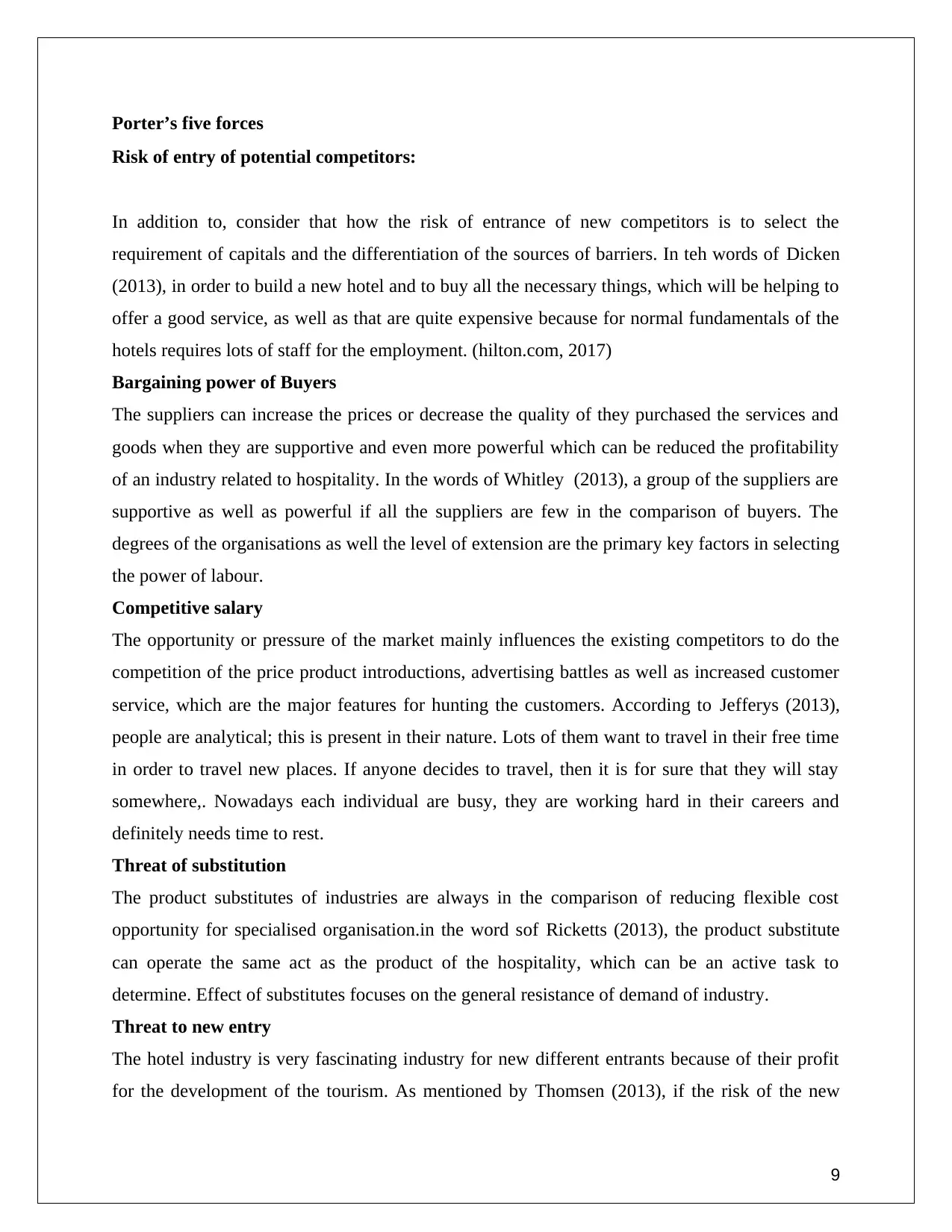
Porter’s five forces
Risk of entry of potential competitors:
In addition to, consider that how the risk of entrance of new competitors is to select the
requirement of capitals and the differentiation of the sources of barriers. In teh words of Dicken
(2013), in order to build a new hotel and to buy all the necessary things, which will be helping to
offer a good service, as well as that are quite expensive because for normal fundamentals of the
hotels requires lots of staff for the employment. (hilton.com, 2017)
Bargaining power of Buyers
The suppliers can increase the prices or decrease the quality of they purchased the services and
goods when they are supportive and even more powerful which can be reduced the profitability
of an industry related to hospitality. In the words of Whitley (2013), a group of the suppliers are
supportive as well as powerful if all the suppliers are few in the comparison of buyers. The
degrees of the organisations as well the level of extension are the primary key factors in selecting
the power of labour.
Competitive salary
The opportunity or pressure of the market mainly influences the existing competitors to do the
competition of the price product introductions, advertising battles as well as increased customer
service, which are the major features for hunting the customers. According to Jefferys (2013),
people are analytical; this is present in their nature. Lots of them want to travel in their free time
in order to travel new places. If anyone decides to travel, then it is for sure that they will stay
somewhere,. Nowadays each individual are busy, they are working hard in their careers and
definitely needs time to rest.
Threat of substitution
The product substitutes of industries are always in the comparison of reducing flexible cost
opportunity for specialised organisation.in the word sof Ricketts (2013), the product substitute
can operate the same act as the product of the hospitality, which can be an active task to
determine. Effect of substitutes focuses on the general resistance of demand of industry.
Threat to new entry
The hotel industry is very fascinating industry for new different entrants because of their profit
for the development of the tourism. As mentioned by Thomsen (2013), if the risk of the new
9
Risk of entry of potential competitors:
In addition to, consider that how the risk of entrance of new competitors is to select the
requirement of capitals and the differentiation of the sources of barriers. In teh words of Dicken
(2013), in order to build a new hotel and to buy all the necessary things, which will be helping to
offer a good service, as well as that are quite expensive because for normal fundamentals of the
hotels requires lots of staff for the employment. (hilton.com, 2017)
Bargaining power of Buyers
The suppliers can increase the prices or decrease the quality of they purchased the services and
goods when they are supportive and even more powerful which can be reduced the profitability
of an industry related to hospitality. In the words of Whitley (2013), a group of the suppliers are
supportive as well as powerful if all the suppliers are few in the comparison of buyers. The
degrees of the organisations as well the level of extension are the primary key factors in selecting
the power of labour.
Competitive salary
The opportunity or pressure of the market mainly influences the existing competitors to do the
competition of the price product introductions, advertising battles as well as increased customer
service, which are the major features for hunting the customers. According to Jefferys (2013),
people are analytical; this is present in their nature. Lots of them want to travel in their free time
in order to travel new places. If anyone decides to travel, then it is for sure that they will stay
somewhere,. Nowadays each individual are busy, they are working hard in their careers and
definitely needs time to rest.
Threat of substitution
The product substitutes of industries are always in the comparison of reducing flexible cost
opportunity for specialised organisation.in the word sof Ricketts (2013), the product substitute
can operate the same act as the product of the hospitality, which can be an active task to
determine. Effect of substitutes focuses on the general resistance of demand of industry.
Threat to new entry
The hotel industry is very fascinating industry for new different entrants because of their profit
for the development of the tourism. As mentioned by Thomsen (2013), if the risk of the new
9
⊘ This is a preview!⊘
Do you want full access?
Subscribe today to unlock all pages.

Trusted by 1+ million students worldwide
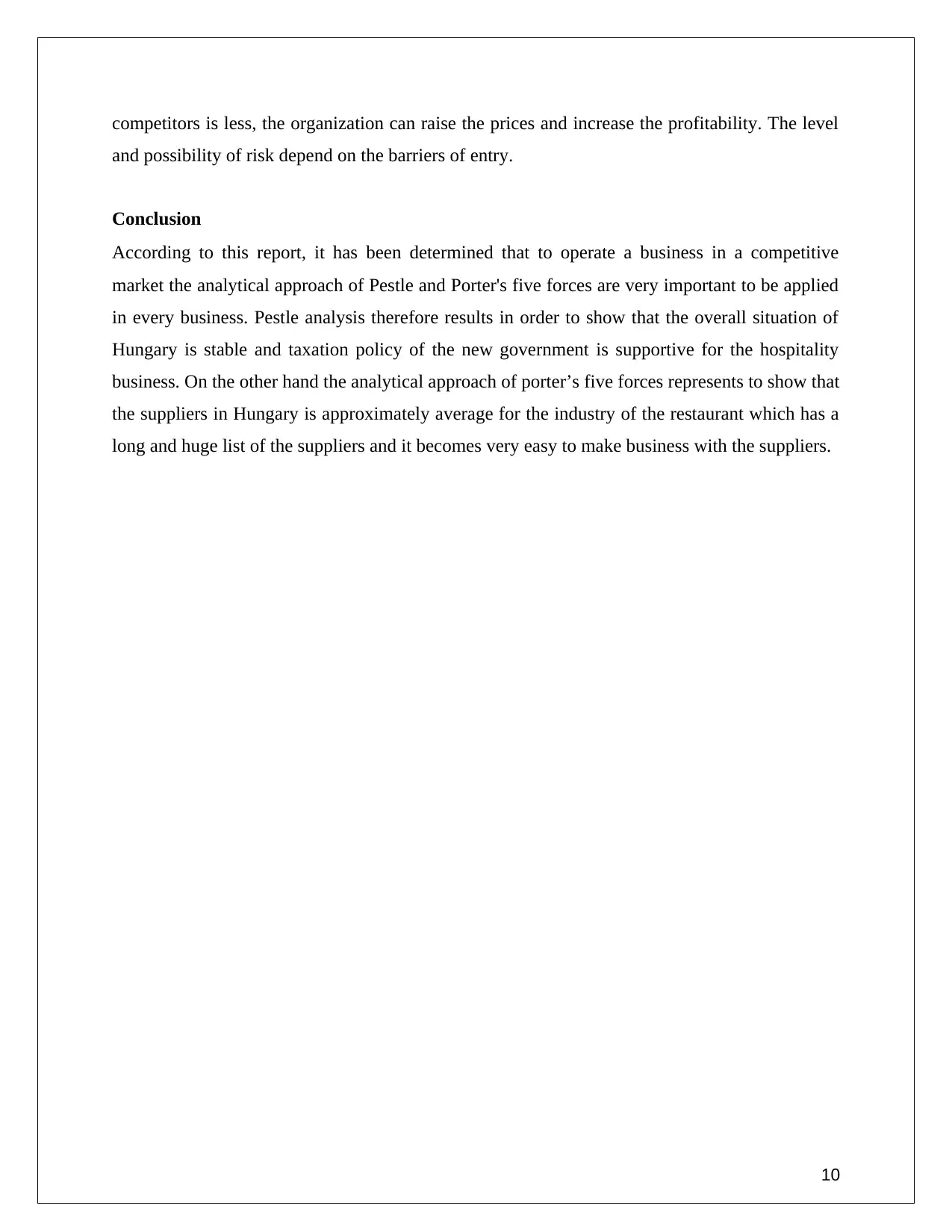
competitors is less, the organization can raise the prices and increase the profitability. The level
and possibility of risk depend on the barriers of entry.
Conclusion
According to this report, it has been determined that to operate a business in a competitive
market the analytical approach of Pestle and Porter's five forces are very important to be applied
in every business. Pestle analysis therefore results in order to show that the overall situation of
Hungary is stable and taxation policy of the new government is supportive for the hospitality
business. On the other hand the analytical approach of porter’s five forces represents to show that
the suppliers in Hungary is approximately average for the industry of the restaurant which has a
long and huge list of the suppliers and it becomes very easy to make business with the suppliers.
10
and possibility of risk depend on the barriers of entry.
Conclusion
According to this report, it has been determined that to operate a business in a competitive
market the analytical approach of Pestle and Porter's five forces are very important to be applied
in every business. Pestle analysis therefore results in order to show that the overall situation of
Hungary is stable and taxation policy of the new government is supportive for the hospitality
business. On the other hand the analytical approach of porter’s five forces represents to show that
the suppliers in Hungary is approximately average for the industry of the restaurant which has a
long and huge list of the suppliers and it becomes very easy to make business with the suppliers.
10
Paraphrase This Document
Need a fresh take? Get an instant paraphrase of this document with our AI Paraphraser
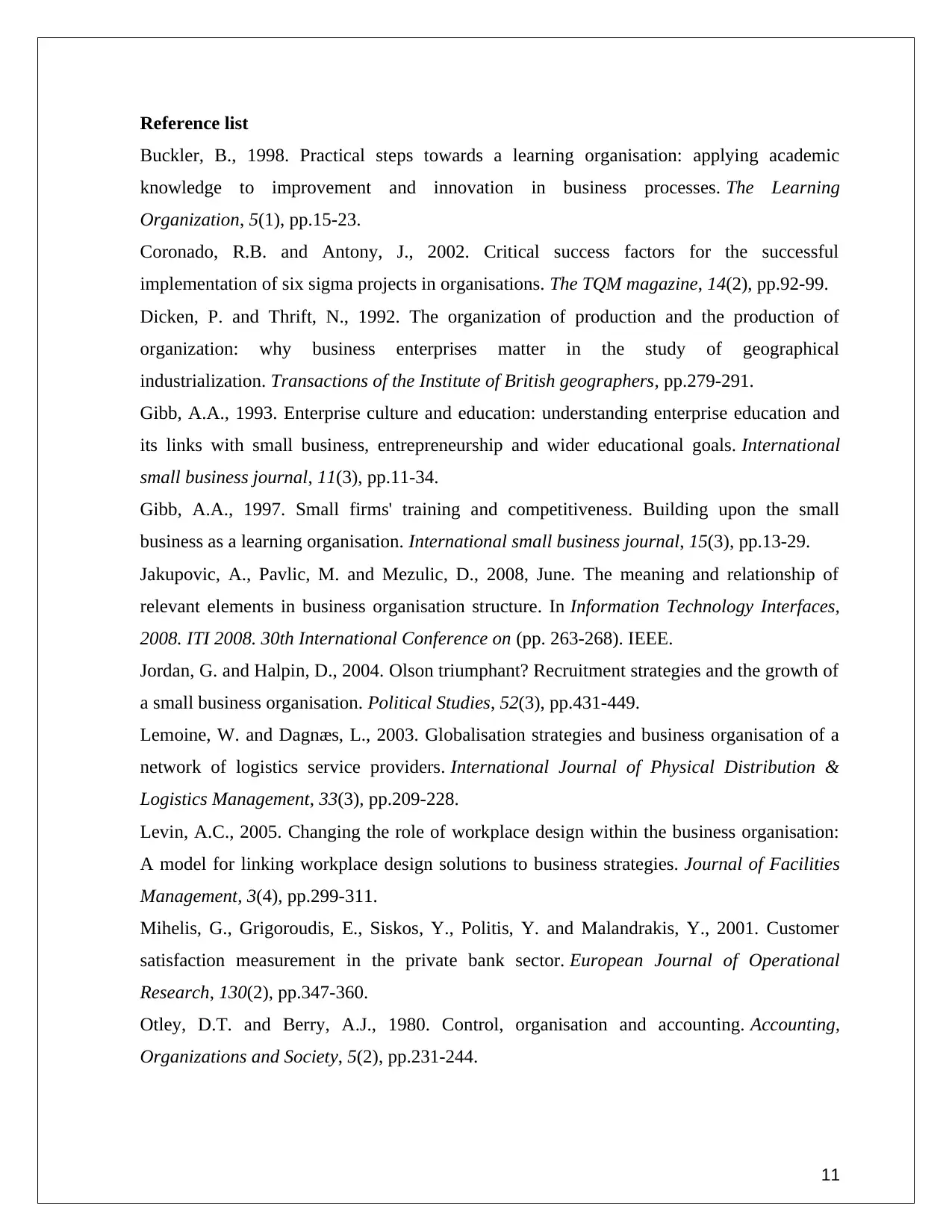
Reference list
Buckler, B., 1998. Practical steps towards a learning organisation: applying academic
knowledge to improvement and innovation in business processes. The Learning
Organization, 5(1), pp.15-23.
Coronado, R.B. and Antony, J., 2002. Critical success factors for the successful
implementation of six sigma projects in organisations. The TQM magazine, 14(2), pp.92-99.
Dicken, P. and Thrift, N., 1992. The organization of production and the production of
organization: why business enterprises matter in the study of geographical
industrialization. Transactions of the Institute of British geographers, pp.279-291.
Gibb, A.A., 1993. Enterprise culture and education: understanding enterprise education and
its links with small business, entrepreneurship and wider educational goals. International
small business journal, 11(3), pp.11-34.
Gibb, A.A., 1997. Small firms' training and competitiveness. Building upon the small
business as a learning organisation. International small business journal, 15(3), pp.13-29.
Jakupovic, A., Pavlic, M. and Mezulic, D., 2008, June. The meaning and relationship of
relevant elements in business organisation structure. In Information Technology Interfaces,
2008. ITI 2008. 30th International Conference on (pp. 263-268). IEEE.
Jordan, G. and Halpin, D., 2004. Olson triumphant? Recruitment strategies and the growth of
a small business organisation. Political Studies, 52(3), pp.431-449.
Lemoine, W. and Dagnæs, L., 2003. Globalisation strategies and business organisation of a
network of logistics service providers. International Journal of Physical Distribution &
Logistics Management, 33(3), pp.209-228.
Levin, A.C., 2005. Changing the role of workplace design within the business organisation:
A model for linking workplace design solutions to business strategies. Journal of Facilities
Management, 3(4), pp.299-311.
Mihelis, G., Grigoroudis, E., Siskos, Y., Politis, Y. and Malandrakis, Y., 2001. Customer
satisfaction measurement in the private bank sector. European Journal of Operational
Research, 130(2), pp.347-360.
Otley, D.T. and Berry, A.J., 1980. Control, organisation and accounting. Accounting,
Organizations and Society, 5(2), pp.231-244.
11
Buckler, B., 1998. Practical steps towards a learning organisation: applying academic
knowledge to improvement and innovation in business processes. The Learning
Organization, 5(1), pp.15-23.
Coronado, R.B. and Antony, J., 2002. Critical success factors for the successful
implementation of six sigma projects in organisations. The TQM magazine, 14(2), pp.92-99.
Dicken, P. and Thrift, N., 1992. The organization of production and the production of
organization: why business enterprises matter in the study of geographical
industrialization. Transactions of the Institute of British geographers, pp.279-291.
Gibb, A.A., 1993. Enterprise culture and education: understanding enterprise education and
its links with small business, entrepreneurship and wider educational goals. International
small business journal, 11(3), pp.11-34.
Gibb, A.A., 1997. Small firms' training and competitiveness. Building upon the small
business as a learning organisation. International small business journal, 15(3), pp.13-29.
Jakupovic, A., Pavlic, M. and Mezulic, D., 2008, June. The meaning and relationship of
relevant elements in business organisation structure. In Information Technology Interfaces,
2008. ITI 2008. 30th International Conference on (pp. 263-268). IEEE.
Jordan, G. and Halpin, D., 2004. Olson triumphant? Recruitment strategies and the growth of
a small business organisation. Political Studies, 52(3), pp.431-449.
Lemoine, W. and Dagnæs, L., 2003. Globalisation strategies and business organisation of a
network of logistics service providers. International Journal of Physical Distribution &
Logistics Management, 33(3), pp.209-228.
Levin, A.C., 2005. Changing the role of workplace design within the business organisation:
A model for linking workplace design solutions to business strategies. Journal of Facilities
Management, 3(4), pp.299-311.
Mihelis, G., Grigoroudis, E., Siskos, Y., Politis, Y. and Malandrakis, Y., 2001. Customer
satisfaction measurement in the private bank sector. European Journal of Operational
Research, 130(2), pp.347-360.
Otley, D.T. and Berry, A.J., 1980. Control, organisation and accounting. Accounting,
Organizations and Society, 5(2), pp.231-244.
11
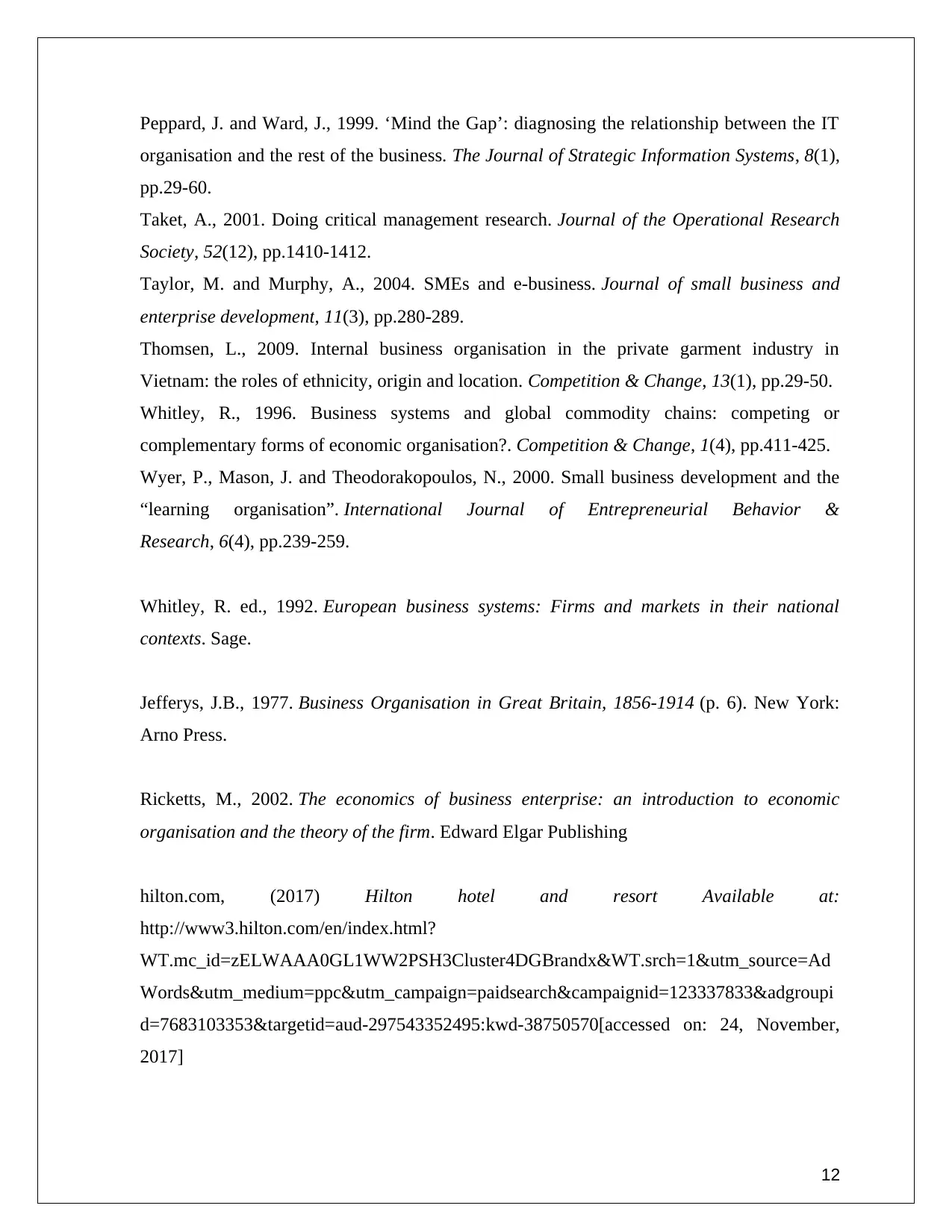
Peppard, J. and Ward, J., 1999. ‘Mind the Gap’: diagnosing the relationship between the IT
organisation and the rest of the business. The Journal of Strategic Information Systems, 8(1),
pp.29-60.
Taket, A., 2001. Doing critical management research. Journal of the Operational Research
Society, 52(12), pp.1410-1412.
Taylor, M. and Murphy, A., 2004. SMEs and e-business. Journal of small business and
enterprise development, 11(3), pp.280-289.
Thomsen, L., 2009. Internal business organisation in the private garment industry in
Vietnam: the roles of ethnicity, origin and location. Competition & Change, 13(1), pp.29-50.
Whitley, R., 1996. Business systems and global commodity chains: competing or
complementary forms of economic organisation?. Competition & Change, 1(4), pp.411-425.
Wyer, P., Mason, J. and Theodorakopoulos, N., 2000. Small business development and the
“learning organisation”. International Journal of Entrepreneurial Behavior &
Research, 6(4), pp.239-259.
Whitley, R. ed., 1992. European business systems: Firms and markets in their national
contexts. Sage.
Jefferys, J.B., 1977. Business Organisation in Great Britain, 1856-1914 (p. 6). New York:
Arno Press.
Ricketts, M., 2002. The economics of business enterprise: an introduction to economic
organisation and the theory of the firm. Edward Elgar Publishing
hilton.com, (2017) Hilton hotel and resort Available at:
http://www3.hilton.com/en/index.html?
WT.mc_id=zELWAAA0GL1WW2PSH3Cluster4DGBrandx&WT.srch=1&utm_source=Ad
Words&utm_medium=ppc&utm_campaign=paidsearch&campaignid=123337833&adgroupi
d=7683103353&targetid=aud-297543352495:kwd-38750570[accessed on: 24, November,
2017]
12
organisation and the rest of the business. The Journal of Strategic Information Systems, 8(1),
pp.29-60.
Taket, A., 2001. Doing critical management research. Journal of the Operational Research
Society, 52(12), pp.1410-1412.
Taylor, M. and Murphy, A., 2004. SMEs and e-business. Journal of small business and
enterprise development, 11(3), pp.280-289.
Thomsen, L., 2009. Internal business organisation in the private garment industry in
Vietnam: the roles of ethnicity, origin and location. Competition & Change, 13(1), pp.29-50.
Whitley, R., 1996. Business systems and global commodity chains: competing or
complementary forms of economic organisation?. Competition & Change, 1(4), pp.411-425.
Wyer, P., Mason, J. and Theodorakopoulos, N., 2000. Small business development and the
“learning organisation”. International Journal of Entrepreneurial Behavior &
Research, 6(4), pp.239-259.
Whitley, R. ed., 1992. European business systems: Firms and markets in their national
contexts. Sage.
Jefferys, J.B., 1977. Business Organisation in Great Britain, 1856-1914 (p. 6). New York:
Arno Press.
Ricketts, M., 2002. The economics of business enterprise: an introduction to economic
organisation and the theory of the firm. Edward Elgar Publishing
hilton.com, (2017) Hilton hotel and resort Available at:
http://www3.hilton.com/en/index.html?
WT.mc_id=zELWAAA0GL1WW2PSH3Cluster4DGBrandx&WT.srch=1&utm_source=Ad
Words&utm_medium=ppc&utm_campaign=paidsearch&campaignid=123337833&adgroupi
d=7683103353&targetid=aud-297543352495:kwd-38750570[accessed on: 24, November,
2017]
12
⊘ This is a preview!⊘
Do you want full access?
Subscribe today to unlock all pages.

Trusted by 1+ million students worldwide
1 out of 14
Your All-in-One AI-Powered Toolkit for Academic Success.
+13062052269
info@desklib.com
Available 24*7 on WhatsApp / Email
![[object Object]](/_next/static/media/star-bottom.7253800d.svg)
Unlock your academic potential
Copyright © 2020–2025 A2Z Services. All Rights Reserved. Developed and managed by ZUCOL.